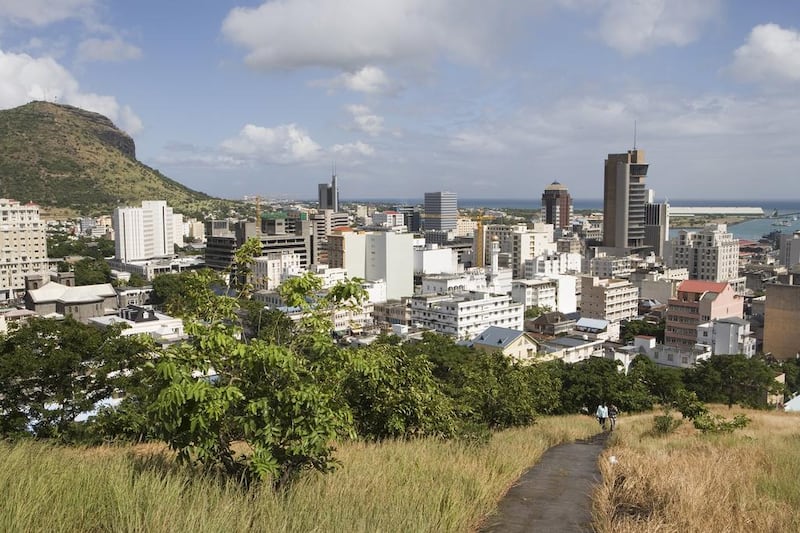Why Port Louis?
Most people bypass the capital of Mauritius to enjoy the tropical island’s sun and sand, but scratch the surface, and the city’s many charms come to the fore. Developed by the French from the mid-18th century, Port Louis boasts eclectic architecture, including French colonial buildings, and historical monuments such as the 19th-century Jummah Mosque and the St James Cathedral. With Victorian warehouses and Creole bungalows with low verandas, houses of worship for every major religion, and busy markets, the city has character stamped all over it. In the past two decades, this sleepy Indian Ocean backwater has spruced up many of its colonial buildings, and its waterfront offers shopping and restaurants.
A comfortable bed
The most opulent option is the recently refurbished Labourdonnais Waterfront Hotel (www.labourdonnais.com), with great waterfront views, plus three restaurants and a bar. Rooms cost from US$300 (Dh1,102) per night.
A waterfront alternative is the family-friendly Le Suffren Hotel & Marina. www.lesuffrenhotel.com. Its 102 rooms are inspired by nature, in shades of green and ivory. This trendy hotel has three restaurants and a bar offering fine dining, as well as a spa. Rooms cost from $190 (Dh698) per night.
You can also stay at a luxury resort in other parts of the island, and explore Port Louis by car from there. The Paradis Hotel & Golf Club (www.beachcomber-hotels.com), has luxurious suites and villas fringed by white sands and the island's largest lagoon. Double rooms cost from $500 per night (Dh1,836), including breakfast.
Find your feet
The best way to get your bearings is to drive to the Moorish-looking Fort Adelaide, also known as the Citadel, which was built out of black rock by the British, to counter any invasion by the French. From its vantage point, take in views of the dramatic Moka Mountains, the Champs de Mars racecourse (the oldest horse-racing track in the southern hemisphere) and the city’s high-rise buildings. Back in the city, start at Place d’Armes, the historical centre, which links the port to the 19th-century Government House through a grand esplanade lined with palm trees and statues.
Walk to the Natural History Museum, which houses exhibits of the country’s fauna, with a gallery devoted to the dodo, the Mauritian bird that was hunted to extinction during the Dutch occupation. Entrance is free.
www.aapravasighat.org) is a simple, rough-stone building that was the immigration depot where the first labourers from India arrived. It's now a Unesco site, a symbol of the connection between India and Mauritius – more than 70 per cent of Mauritians are of Indian origin.
Meet the locals
Soak up the hustle and bustle at the noisy Central Market on Farquhar Street, in the heart of the old town, with its Victorian arcades. The air is scented with the smell of chillies and overripe pineapples. From here walk to the Jummah Mosque, with intricately carved teak doors and green windows. Built in the 1850s, it’s a harmonious blend of Creole, Indian and Islamic architecture. Spend some time at the shady Jardin de la Compagnie, a public park with beautiful banyan trees and statues of local leaders. This is where locals catch up on gossip and eat packed lunches.
Book a table
To sample simple, tasty street food, head to the area around the Central Market, where Indian, Chinese and Creole cooks dish up spicy lentil wraps, dhal poori, noodles doused in chilli sauce, and Alouda, a local drink made with Indian basil, milk and vanilla ice cream.
For classy dining, The Courtyard, on Rue Chevreau, serves French cuisine in a beautiful al fresco space. A meal for two costs about Dh185.
For local food in a casual ambience, La Bonne Marmite, on Sir William Newton Street, in the heart of town, offers Indian, European and Creole staples such as rougaille, poisson sale and heart of palm tree. A meal for two costs about Dh200.
Café de Vieux Conseil, on Rue de Vieux Conseil, has a colonial ambience, with a paved garden and a tree-shaded courtyard hidden on a side street. The menu offers a variety from crêpes and Creole salads through to smoked marlin. A meal for two costs about Dh250.
Shopper’s paradise
Le Caudan Waterfront complex (www.caudan.com is a gentrified area that boasts a promenade with cinemas, a craft market and air-conditioned shopping malls. Shop for beach wraps, wooden sculptures, designer clothing, paintings, glassware and Mauritian spices at the Le Caudan Waterfront Craft Market, which has more than 30 stalls painted in bright colours, including Mast, where you can pick up wooden replica ships crafted in Mauritius.
Shop for local souvenirs at the Central Market, where stalls sell woven baskets and table mats in rainbow colours and dodo figurines. The Citadel has exclusive boutiques, including Tresor, a jewellery and diamond shop. And the upmarket Bagatelle mall (www.mallofmauritius.com), on the outskirts of Port Louis, offers more than 150 shops and a food court, with the widest selection of speciality shops in Mauritius.
Don’t miss
The Blue Penny Museum is home to old postage stamps, including the rare orange-red one penny and deep-blue two pence bearing the profile head of Queen Victoria. The ground-floor is devoted to the lovers Paul and Virginia from Bernardin de Saint-Pierre's novel. The museum also displays old marine maps, engravings, paintings and documents that portray Mauritian history and culture. Entrance is Dh23.
What to avoid
Local taxi drivers often work with commercial outlets such as galleries and shops. Rent a car and hire a local guide.
Getting there
Emirates flies direct from Dubai to Port Louis, from about Dh3,450.on










